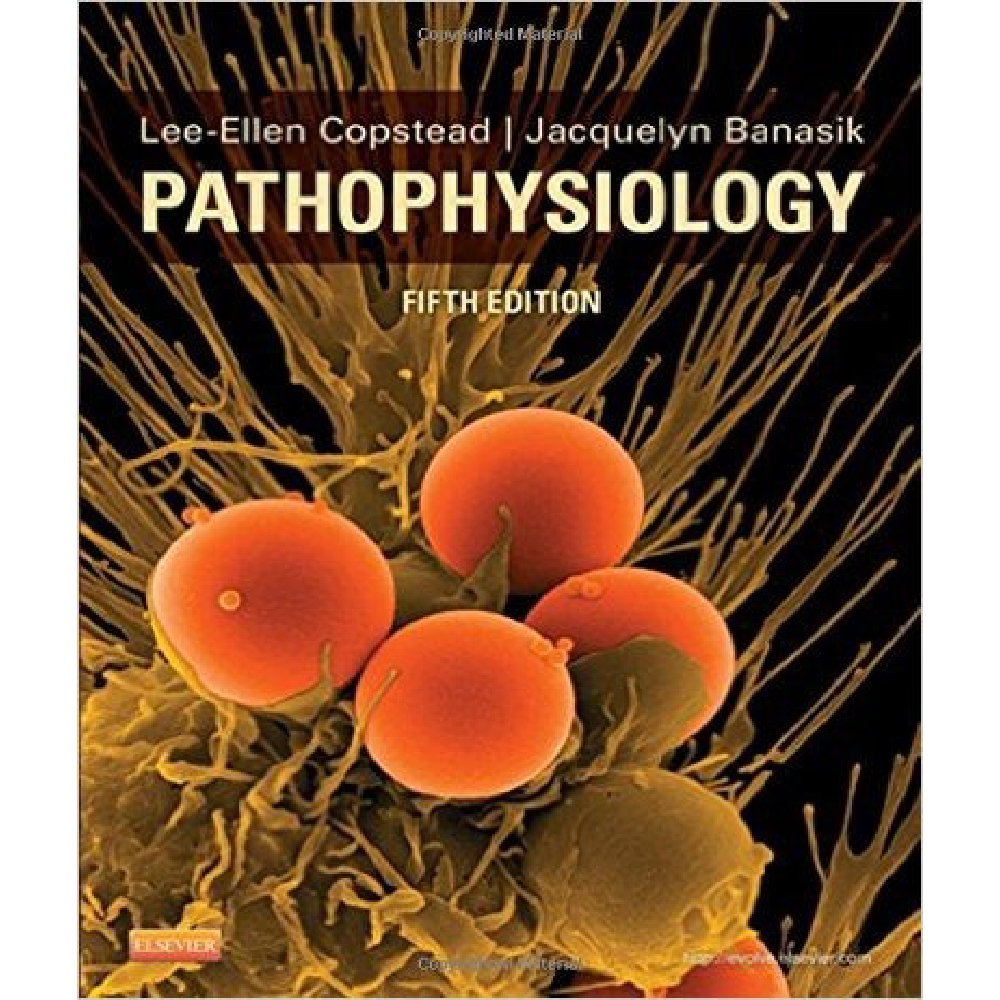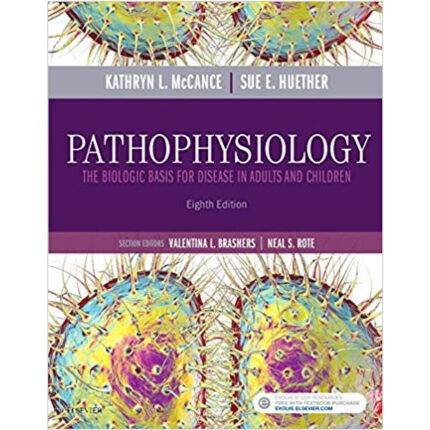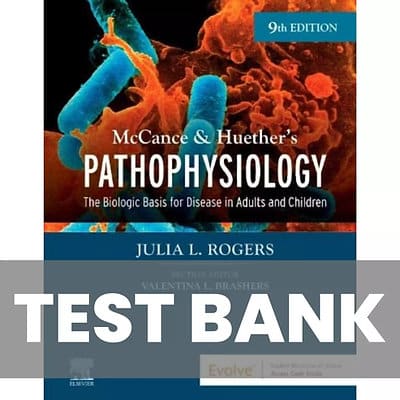Pathophysiology 5th Edition By Lee-Ellen C. Copstead – Test Bank
Chapter 11: Malignant Disorders of White Blood Cells
Test Bank
MULTIPLE CHOICE
1. The major cause of death from leukemic disease is
a. infection.
b. malnutrition.
c. hypovolemic shock.
d. kidney failure.
ANS: A
Infection is the most common cause of death in the immunocompromised patient, because it can become a life-threatening sepsis.
Malnutrition can be a side effect of the disease process or the treatment. Hypovolemic shock is not generally associated with
leukemic disease. There is no direct connection between kidney failure and death in leukemia, although kidney failure may occur as
a result of treatment.
REF: Pg. 218
2. A 58-year-old woman is seen in the clinic for reports of severe back pain. Her chest X-ray demonstrates generalized bone
demineralization and compression fracture. Blood studies demonstrate elevated calcium levels. The most likely diagnosis is
a. leukemia.
b. myeloma.
c. Hodgkin disease.
d. back trauma.
ANS: B
A diagnosis of plasma cell myeloma is confirmed by the presence of hypercalcemia, which can contribute to the compression
fracture. Patients with leukemia diagnoses do not exhibit bone demineralization or elevated calcium levels. Lymphadenopathy is a
more common manifestation of Hodgkin disease. Compression fractures can be the result of back trauma, but not in the presence of
the other radiographic and laboratory results.
REF: Pg. 225
3. Renal insufficiency is a common complication of which disease?
a. Chronic myeloid leukemia (CML)
b. Chronic lymphoid leukemia (CLL)
c. Myeloma
d. Hodgkin disease
ANS: C
Renal insufficiency is seen in approximately 50% of patients with plasma cell myeloma, due to hyperproteinemia, Bence Jones
protein, hypercalcemia, and hyperuricemia. Chronic myeloid leukemia is manifested by splenomegaly. Chronic lymphoid leukemia
is a disease that affects lymphoid tissues and bone marrow. Malignancy along lymphatic pathways is more typical of Hodgkin
disease.
REF: Pg. 225
4. The patient is a 12-year-old boy diagnosed with acute lymphoid leukemia (ALL). As part of treatment, the patient must undergo
several weeks of chemotherapy. The most serious complication of chemotherapy is
a. vomiting.
b. anemia.
c. alopecia.
d. infection.
ANS: D
Infection is the most troublesome complication of chemotherapy for the immunosuppressed patient, and infection is a major cause
of death in a leukemic patient. Nausea and vomiting are common findings in the treatment phase. While anemia is a common
complication of the disease and treatment, it is not as serious as immunosuppression. Alopecia is an unfortunate side effect of
chemotherapy, but is not a life-threatening complication.
REF: Pg. 218
5. While in the hospital for management of acute lymphoid leukemia (ALL), a patient develops severe thrombocytopenia. The most
appropriate action for this condition is
a. anticoagulant therapy.
b. chemotherapy.
c. activity restriction.
d. isolation.
ANS: C
Thrombocytopenia can produce a life-threatening hemorrhage. Patients with this condition should be protected from trauma and
placed on activity restriction to reduce the risk of bleeding. Anticoagulant therapy in a patient with thrombocytopenia could actually
cause the patient more bleeding. Thrombocytopenia is a complication of leukemia and chemotherapy. Chemotherapy is not an
appropriate treatment option for thrombocytopenia. Isolation is not effective in managing the risk of hemorrhage.
REF: Pg. 220
Copyright © 2013, 2010, 2005 Saunders, an imprint of Elsevier Inc. All rights reserved. 2
6. The Philadelphia chromosome is a balanced chromosome translocation that forms a new gene called
a. bcr-abl.
b. Rb.
c. p53.
d. ARA-c.
ANS: A
bcr-abl is the translocation of chromosomes 9 and 22, which are known as the Philadelphia chromosome. Rb is a retinoblastoma
protein, which is not associated with the Philadelphia chromosome. p53 is a tumor suppressor not associated with the Philadelphia
chromosome. ARA-c is a chemotherapeutic agent used to treat leukemia.
REF: Pg. 221
7. Which form of leukemia demonstrates the presence of the Philadelphia chromosome?
a. ALL (acute lymphoid leukemia)
b. CLL (chronic lymphoid leukemia)
c. AML (acute myeloid leukemia)
d. CML (chronic myeloid leukemia)
ANS: D
The majority of CML cases are characterized by malignant granulocytes that carry the Philadelphia chromosome. ALL is manifested
by the malignant transformation of B cells and some T cells. CLL is associated with T-cell transformation. The Philadelphia
chromosome is not seen in CLL. AML is associated with a transformation of a myeloid stem cell.
REF: Pg. 221
8. In general, the best prognosis for long-term disease-free survival occurs with
a. ALL (acute lymphoid leukemia).
b. CLL (chronic lymphoid leukemia).
c. AML (acute myeloid leukemia).
d. CML (chronic myeloid leukemia).
ANS: A
ALL is highly curable in the pediatric population with an 85% survival rate in children. The average age of patients with CLL is 65
to 70 years. Median survival rate is less than 8 years. Patients younger than age 60 have a 4-year survival rate of 30% to 40% in
AML. CML does not respond well to chemotherapy and carries a long-term survival rate of 50% to 60%.
REF: Pg. 224
9. Which type of leukemia primarily affects children?
a. ALL (acute lymphoid leukemia)
b. CLL (chronic lymphoid leukemia)
c. AML (acute myeloid leukemia)
d. CML (chronic myeloid leukemia)
ANS: A
ALL is primarily a disorder of children. The peak incidence occurs between the ages of 3 and 7 years. The average age of patients
with CLL is about 65 to 70 years. The median age of presentation of AML is 64 years. Average onset of CML is between 40 and 50
years.
REF: Pg. 223
10. Which group of clinical findings describes the typical presentation of ALL (acute lymphoid leukemia)?
a. Pain in long bones, infection, fever, bruising
b. Vertebral fracture, hypercalcemia, bone pain
c. Elevated WBC count found on routine exam, asymptomatic
d. Painless enlarged cervical lymph node, fever, weight loss
ANS: A
The onset of symptoms of ALL is abrupt and may begin when a child refuses to walk or begins to exhibit loss of appetite, fatigue,
or abdominal pain. Bruising, fever, and infection are also common early findings. Vertebral fractures, elevated calcium levels, and
bone pain are more frequently associated with plasma cell myeloma. Asymptomatic onset is generally found with CLL and is often
found by accident on a routine blood count. Enlarged cervical lymph nodes are seen more commonly in Hodgkin disease.
REF: Pgs. 223-224













Reviews
There are no reviews yet.